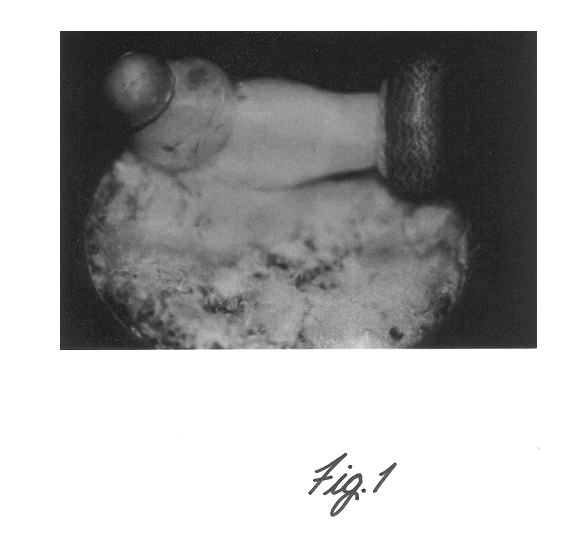Method of cultivating fruit bodies of agaricus blazei in artificial mushroom cultivation bed
- Summary
- Abstract
- Description
- Claims
- Application Information
AI Technical Summary
Benefits of technology
Problems solved by technology
Method used
Image
Examples
example 1
Cultivation of a Agaricus (Agaricus blazei Murrill) in a Bottle
1. Preparation of a Medium:
Seeds of Deccan grass, foxtail millet and Chinese millet were mixed at a dry weight ratio of 2:2:1, and then water of twice the weight amount of the resultant mixture was added and boiled. When most of the water was evaporated, boiling was stopped and the resultant mixture was cooled.
When the resultant medium was cooled to a temperature of 20.degree. C. or lower, 600 g of the medium was put into each of a plurality of polypropylene bottles having an opening with a diameter of 58 mm and a capacity of 850 ml, and the bottles were capped. Next, high pressure vapor sterilization was performed at 1 atm (gauge pressure) at 121.degree. C. for 60 minutes. Then, the bottles were cooled in a clean room until the temperature of the medium decreased to 18.degree. C.
2. Inoculation of Agaricus:
Spores were harvested from fruit bodies of commercially available Agaricus (Agaricus blazei Murrill), and germinatio...
example 2
Cultivation of a Agaricus (Agaricus blazei Murrill) in a Bag
1. Preparation of a Medium:
Rice bran and wheat chaff as grain, cow manure as a nutrient, and sawdust as a medium matrix were mixed at a weight ratio shown in Table 1 below, and then kneaded with water. Different types of sawdust have different water contents. In this example, sawdust having a water contents of 63% was used. Heat-resistive polypropylene bags were each filled with 1500 g of the resultant mixture. Next, high pressure vapor sterilization was performed at a pressure of 1 atm (gauge pressure) at a temperature of 121.degree. C. for 60 minutes. Then, the bags were cooled in a clean room until the temperature of the medium decreased to 18.degree. C.
2. Inoculation of Agaricus:
A spawn was obtained in the same manner as described in section 2 of Example 1. Inoculation was performed by mixing 80 g of the spawn and the sterilized medium contained in each of 20 bags obtained in section 1, Example 2, supra. (The volumetric...
PUM
 Login to View More
Login to View More Abstract
Description
Claims
Application Information
 Login to View More
Login to View More - R&D
- Intellectual Property
- Life Sciences
- Materials
- Tech Scout
- Unparalleled Data Quality
- Higher Quality Content
- 60% Fewer Hallucinations
Browse by: Latest US Patents, China's latest patents, Technical Efficacy Thesaurus, Application Domain, Technology Topic, Popular Technical Reports.
© 2025 PatSnap. All rights reserved.Legal|Privacy policy|Modern Slavery Act Transparency Statement|Sitemap|About US| Contact US: help@patsnap.com


